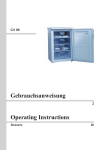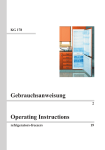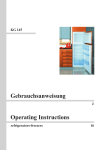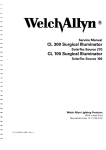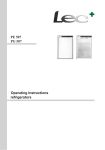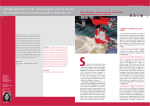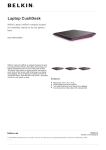Download Gebrauchsanweisung Operating Instructions
Transcript
KS 88 Gebrauchsanweisung für Kühl- und Gefriergeräte 2 Operating Instructions 17 Content Safety Measures ................................................................................ 20 Product Characteristics ..................................................................... 21 Before You Start ................................................................................. 23 Operation........................................................................................... 23 Maintenance and Service ................................................................. 26 Switching the Door Mounting ............................................................ 28 Changes in intenal and external appearance of a product, not affecting its functionality and safety, f, ex. shape of a door handle, surprint on a glass shelf, are acceptable. 18 Dear Customer, The product you have purchased belongs to our new family of refrigerators. They feature modern solutions as regards their functionality, soft line and refiend design. Read the following descriptionin ordrer to see, while you read the manual and use the appliance, the advantages of the new line of refrigerators and become convinced that you have made a good buy. Innovative technology that ensure high quality of our appliances involves: • fully environment-friendly appliance - the refrigerant, construction materials and the manufacturing know how do not contain any substances harmful to the environment, • our „fresh- line +” line of products is not only an elegant design, but also streamline shapes, making keeping the refrigerator sanitary clean easy - there is no room for mould and bacteria, • adjustable shelves, thanks to the Volta system we applied, can be adjusted to accommodate products of different height and, additionally, can be set at an angle (for a safer bottle storage), • sturdy door will hold a load of products arranged on capacious door shelves, • solid insulation of our refrigerators ensures high efficiency and low energy consumption, • self-defrosting fridge compartment limits cleaning to a periodical wash of the compartment, • shelves made from tempered glass with original graphics offer not only durability and visual pleasure but also maximum use of shelf space (even the smallest wine glass stands stable, and incidentally spilled cream will not drip on lower shelves), • transparent containers for vegetables are very capacious and, due to their streamline shape, easy to clean, • ergonomic door handles, big and modern-shaped, with no sharp edges, make opening the door easy, • optimally situated lighting ensures perfect illumination of the whole compartment and prevents from dazzling the user. The esthetic finishing, selection of graphics and colors ensure positive visual sensations and the technical solutions and operating parameters guarantee comfortable use of the product. 39 We wish you the greatest satisfaction. THE APPLIANCE ASSEMBLY IN A FURNITURE NICHE IS TO BE CARRIED OUT ACCORDING TO THE FOLLOWING „ FURNITURE BUILD-IN ASSEMBLY INSTRUCTION” for the appliances types: KSG 88, KSG 123 19 Safety Measures • The producer in not responsible for any damage resultant from violating the principles in the manual. Thus, read carefully the information on safety measures, operation, and maintenance of the refrigerator. • Please keep the Manual for future use or for handing it over to the next user. Before you turn the refrigerator on. • When placing, moving or lifting the refrigerator, do not hold the door handle, do not pull the condenser at the back of the refrigerator, and do not touch the compressor unit. • The refrigerator operates properly in the ambience temperature from +16°C to +32°C. Do not use it in cellars, vestibules, and in summerhouses not heated in fall and winter. • After placing the refrigerator, wait two hours before you turn it on, for it could have been excessively tilted in transport. • Make sure children do not use the appliance unattended. Do not allow children play with the appliance. Children are not allowed to swing on the doors. • Expanding and shrinking of parts caused by temperature changes causes crackling sounds that may be heard. • Before any maintenance activity, pull the plug out, do not pull the cord but hold firmly the plug. • Do not use double-wire extension cords; if an extension cord is necessary, make sure it is a cord with protection safety certificate. • If the main power supply cord is damaged, it should be replaced by a serviceman. • Because of safety reasons, do not repair the appliance by your- self. Repairs carried out by persons without proper qualifications can cause serious risk of injury for the user. • Defrosted products, even only partially, should not be frozen again. • Do not store beverages in bottles and cans, especially carbonated beverages, in the freezing chamber. The bottles and cans could break. • Do not put products straight from the freezer in the mouth (ice cream, ice cubes, etc.). Their very low temperature can cause severe burns. • If the appliance is not to be used any more, make it completely safe prior to scrapping by cutting the cord. • Keep the packaging material (bags, Styrofoam pieces, etc.) out of reach of children. • Should the refrigerating unit be damaged, air the room for a few minutes (the room should have at least 4 cubic meters). • The cooling agent can cause eye injury. • The refrigerator should not be transported, moved, or placed in horizontal position and tilted more than 40ˇ. Should such a situation occur, after placing the appliance in the right position wait at least 2 hours before turning it on. 20 Product Characteristics Single-compressor refrigerators (Phot.1) are designed for household use. The refrigerator chamber should be used exclusively for storage of fresh grocery products and the freezer chamber for freezing fresh produce, storage of frozen food, and making ice cubes only. The refrigerators are designed for operation in the ambient temperaure from +16°C to +32°C. The elements of the cooling system of the appliance are locatedMbehind the back wall of the chamber in order to maximize the capacity of the chamber, facilitate keeping the chamber clean and increase durability of the product (protecting from potential damage). Shelves are made of safe tempered glass (Phot.2). They can be cleaned the normal way or in dishwashers. Special construction of the frames for the glass shelves (Phot.2) makes it possible to adjust the distance between the shelves. In order to change the distance between the shelves: • take out the frames, • place the glass the printed side facing down, • re-install the frames adjusting the distance between the shelves as needed. The photographs present 2 examples of placing the shelves in the refrigerator. • distance between the shelves decreased (Phot.3), • distance between the shelves increased (Phot.4). Installation and removal of shelves: • In order to take out a shelf hold the right side of the shelf, lift the left side with your left hand about 45° and take the shelf out (Phot.5). • Start taking out the shelf for cleaning with the top one, start putting them back in with the bottom one. • Shelves are installed as follows: - put the shelf in at an angle about 45° (just like taking it out) - align the projections with the groves located at the sides of the refrigerator chamber. Accessories framed glass shelf glass shelf vegetable container door shelf door shelf cover egg holder freezer shelf plastic bags for ice cubes building-in set 2 KSG 88 2 pieces 1 piece 1 piece 3 pieces 1 piece 2 pieces --1 set 1 set 21 Product Characteristics Accessories KSG 123 framed glass shelf glass shelf vegetable container door shelf door shelf cover egg holder freezer shelf plastic bags for ice cubes building-in set 3 pieces 1 piece 1 piece 4 pieces 1 piece 2 pieces 1 set 1 set 1 set2 Technical parameters: KSG 88 Height Width Depth Net capacity: total refrigerator freezer Weight Power supply Total rated power freezing capability Defrosting of refrigerator freezer 862 mm 558 mm 540 mm 22 KSG 123 1220 mm 558 mm 540 mm 127 l 110 l 17 l 36 kg 230 V ~50 Hz 69 W 2 kg / 24 h 192 l 154 l 38 l / 37 l 51 kg 230 V ~50 Hz 100 W 2,5 kg / 24 h automatic manual automatic manual Before You Start Placement of the product • Unpack the product; remove the tape securing the door and the accessories. Remove the remains of the glue, if any, with delicate cleaning detergent. • Do not throw the Styrofoam element of the packaging away. Should you have to transport the product again, secure the refrigerator with the Styrofoam elements, the plastic foil, and Scotch tape. • Wash the inside of the refrigerator chamber and the accessories with lukewarm water with some dishwasher liquid and then wipe it and dry. • Place the refrigerator in a dry, ventilated place, out of sun, far from such heat sources as the oven, central heating radiators, etc. If it is impossible to place the refrigerator away from a heat source, use an appropriate insulation board or make sure the distance from the refrigerator is: - at least 3 cm from electric or gas cookers, - at least 30 cm from oil or coal-fired stoves. • If you place the refrigerator next to another refrigerating of freezing unit, the lateral distance between the appliances should be at least 2 cm. • Once placed, make sure the refrigerator is not standing on the power supply cord. • No adjustments of the cooling unit are allowed. Make sure that the capillary tube, located in the recess of the compressor, is not damaged (Phot.6 (1)). The tube cannot be deformed, straightened, or coiled. Damage of the capillary tube by the user waives the guarantee of the refrigerator. • For easy opening of the refrigerator door the distance between the side (the hinges side) and the room wall should be at least 5 cm. Connection to the power supply system • We advise setting the temperature control dial to „0” before the connection. • The appliance should be connected to a system of alternating current, 230 V / 50 Hz, through a properly installed socket. Operation Temperature control • Setting the control dial to one of selected positions automatically adjusts the temperature both in the refrigerator and in the freezer. There are 8 settings of the control dial: „0” - the appliance is off „1” - the highest temperature in the refrigerator and the freezer (warmest) „2” to „6” - intermediate settings „7” - the lowest temperature in the refrigerator and the freezer (coldest) • Do not overfill the refrigerator and the freezer chambers before they are cooled down. 23 Operation Storage of produce in the refrigerator • Produce should be placed on plates, in containers or packaged with food wrap. Place it evenly on the shelves. Make sure the food is not touching the back wall - it could lead to frosting or wetting of the products. • Do not put any dishes with hot content into the refrigerator. • Products easily taking over foreign flavors, such as butter, milk, farmer cheese, and product with intense flavor, such as fish, smoked meat, hard cheese, should be placed on the shelves packaged in food wrap or in tightly sealed containers. • Food should be stored in different refrigeration zones, depending on their type and shelflife. Use the figures on page 14, 15 when selecting the zone for a product. • Storage of vegetables, containing a lot of water, can cause deposition of steam on the vegetable containers; it does not impact proper operation of the refrigerator. • Dry the vegetables thoroughly before putting them into the refrigerator. • Excessive moisture shortens shelflife of vegetables, especially leafed vegetables. • Do not wash vegetables before storing in the refrigerator. Washing removes natural protection, it is better to wash vegetables directly before consumption. • Beverages should be stored in tightly sealed bottles. • Note! Do not allow contact of oil and fat with plastic elements and the door gasket. Freezing food • Practically, all the food products except vegetables consumed raw, such as lettuce, can be frozen. • Only food products of the highest quality, divided in small portions for single use, should be frozen. • Products should be packaged in material that is odorless, resistant to air and moisture penetration, and not susceptible to fat and lye. • Plastic bags, polyethylene and aluminum sheets are the best wrapping material types. • The packaging should be tight and stick to the frozen product. Do not use glass packaging. • We advise not to place more than 2,5 kg of fresh food at a time to the freezer per day. • In order to maintain good quality of the frozen food in the freezer reorganize it so as it does not touch food that is not frozen yet. • The bottom, back and top walls of the freezing chamber transmit cold to the products. Thus, portions that are to be frozen should be placed next to those surfaces. • We advise moving the already frozen products aside and placing the fresh products that are to be frozen in the middle of the freezing chamber. • Set the temperature dial to „7” 2-3 hours prior to storing fresh products in the freezer. After placing the fresh products in the freezer, set the dial to „4” - „5”. • If you notice that during the freezing process, provided unfavorable operating condition of the product or higher quantities of food being frozen, the temperature in the refrigerating chamber dropped below 0ˇC, turn the temperature dial to „1” - „2”, it will temporarily turn the compressor off. After about 2 - 3 hours turn the dial to normal use position. It is particularly important 24 Operation for storing food susceptible to temperatures below 0ˇC in the refrigerating chamber (such as eggs, liquids in glass containers, etc.). • Remember that the temperature in the refrigerator is effected by such factors as the ambient temperature, quantities of food in the chamber, frequency of opening the door, amount of frost in the freezing chamber. • The freezing chamber can be used for freezing fruit and making ice cubes. • If you use boiled water for making ice, ice cubes will be transparent. Defrosting food • Depending on the type of food and the way they are to be used, it can be defrosted in the refrigeration chamber, in a dish with lukewarm water, in a microwave oven, in an electric oven, or let self-defrost in room temperature. • Fruit and vegetables for boiling do not need to be defrosted. • Defrosted food should be used the same day or stored in the refrigeration chamber not longer than for one more day. Even if the product is defrosted partially, you mustnŐt refreeze it. But you can freeze dishes containing defrosted ingredients. Defrosting the refrigerator Frost settles on the back wall of the refrigeration chamber. It is automatically removed. During the defrosting, the condensate can contain some impurities that could clog up the opening in the through. Should it occur, delicately unclog the opening with the cleaning plug. (Phot.7). The appliance operates in cycles: it refrigerates (frost sets on the back wall during the phase) and defrosts (water flows down the back wall). • Bigger deposits of ice on refrigerating surfaces deteriorate the appliance´ s performance and increase electricity consumption. • If the appliance contains any products, set it to „7” about 4 hours prior to the planned defrosting; it will ensure possibility of storing the frozen food for an extended period of time in the room temperature. • Do not place an electric heater, heating fan or a hair dryer in the refrigerator under any circumstances. • Take the food out of the freezer, put it in a bowl, wrap it with a few layers of paper (you can use newspapers), wrap it in a blanket, and store in a cold place. • We suggest combining the defrosting and cleaning of the freezer with cleaning of the refrigerating chamber. • Absolutely set the temperature control dial to „0” and unplug the appliance before cleaning. • Empty the refrigerator. • Wait about 30 minutes. Now you can easily remove frost from the smooth wall surfaces using a plastic or wooden spatula (Phot. 8) Notice! A scraper is not included among the accessories. • Wash and dry the inside of the refrigerator. • Wash thoroughly all accessories ( vegetable containers, door shelves, glass shelves, shelf frames). 25 Operation • Turn on the appliance according to the relevant section in the manual. • The whole appliance except the door gasket can be cleaned with mild cleaning detergent. The door gasket should be cleaned with water only and wiped dry. Detergents containing abradant or acids are not suitable for the cleaning. Maintenance and Service Exchanging the bulb • Set the dial to „0” and unplug the appliance. • Unscrew the bulb cover with a cross-head screwdriver and take the cover off (Phot.9). • Exchange the bulb with a new one observing the parameters: 220 - 240 V, max. 15 W, E14 thread, maximum bulb dimensions: diameter - 26 mm, length - 55 mm. • Put the cover back and tighten it with the screws (Phot.10). Energy saving • Place the refrigerator away from heat sources (such as radiators and ovens (Phot11). • Make sure air can circulate freely around the refrigerator, • Let dishes cool down before putting them into the refrigerator, at least to room temperature. • Move the frozen food to the refrigerator while defrosting. You will utilize the low temperature of the frozen food for cooling the products stored in the refrigerator chamber. • Defrost when there are ice deposits. Thick layer of ice hampers cold transition to the food and increases electric energy consumption. • Keep the door open as shortly as possible when putting in or taking out food. The shorter the time the less ice will deposit on the freezer walls. • Adjust the dial setting to the degree the refrigerator / freezer is filled up to. Knowing that you will not use the refrigerator for a longer period of time: • Set the temperature control dial to „0” and unplug the appliance. • Empty the appliance. • Clean and dry the refrigerator. Wash carefully all the accessories (vegetable containers, door shelves, glass shelves, shelf frames). • Leave the refrigerator door slightly open to prevent the chambers from getting unpleasant smell. • You may come across small problems while using the refrigerator that you can repair yourself. • By repairing yourself any problems except the ones listed in the table below inevitably waives the guarantee rights. 26 Maintenance and Service Problem Reason Solution The appliance does not work A gap in the elec tric system circuit - make sure the plug is properly inserted into the socket, - make sure there is electricity in the socket by plugging in another electric device, such as a night lamp, - make sure the power supply cord is not damaged, The compressor hardly ever activates - make sure the ambient temperature is not below +16°C, The lighting inside the chamber does not work The bulb is loose - first do the tests men tio ned above (the appliance does not work), - tighten the bulb or replace with a new one, The temperature inside the chambers is not low enough (the compressor operates continuously) The door does not shut tight or is opened too often - rearrange the products so as they do not hamper the door, - shorten the time the door is opened, The ambient temperature is above +32°C - the appliance is designed for operation in temperatures from +16°C to +32°C, Air circulation at the back of the appliance hampered - move the appliance a bit away from the wall, The appliance is placed in a sunny place or near a heat source - move the appliance to a different place, The food to uches the back wall of the refrigerator chamber - move the food or containers away from the back wall, The drain opening is clogged - take the cleaning plug and unclog the condensate opening, The appliance is not level - level the appliance, The appliance is touching a piece of furniture or other objects - place the appliance detached, so as it is not touching any objects. Water collects at the bottom part of the refrigerator chamber The appliance makes too much noise 27 Switching the Door Mounting Side Switching the freezer door mounting side in KSG 123 • Open the door a crack. • Unscrew the two screws fastening the door latch (Phot. 12), take out the plugs from the additional openings. • Unscrew the right door hinge (Phot. 13) • Turn the door 180° and fasten the hinges on the left side in the previously drilled openings. • Fasten the door latch on the right side. • Insert the plugs into the two visible openings. Switching the freezer door mounting side in KSG 88 • • • • • Open the door wide. Unscrew the two screws fastening the door latch (Phot. 12). Unscrew the hinges (Phot. 13) Turn the door 180° and fasten the hinge replacing the latch. Fasten the door latch replacing the hinge. Different sounds may be heard during operation. The sounds do not effect correct operation of the refrigerator. The sounds that can be heard during normal operation: • clicks - heard when the thermostat activates or deactivates the compressor • buzz - the sound of the compressor intensely working shortly after its activation • crackles and clatter - coming from the cooling system, caused by expansion and shrinking of parts due to temperature differences before and after compressor activation • rustle, gurgle, whistle - coming from the cooling system piping, caused by the coolant flowing inside. Easily corrigible sources of noise: • noise caused by the appliance positioned not level - adjust the position with the adjustable turn-in front feet. You can also put some soft cloth under the back rollers, especially, when the floor is tiled. • rubbing the adjacent piece of furniture - move the refrigerator a bit. • creaking of the drawers and shelves - take out and put back the drawer or shelf. • sounds of clinking bottles - move the bottles apart. Disposing of the device When disposing of the device, do not bring it to regular municipal waste containers. Instead, bring it to electrical and electronic waste recycling and reuse center. A relevant label has been put on the device, its instructions manual, or on the package. The device has been manufactured of recyclable materials. By bringing old device to recycling collection center, you show that you care about nature. Ask your local environmental care authority for information on location of such facilities. 28 KSG 123 1 KSG 88 Zchng. 1 2 3 4 5 1 6 7 8 9 10 NEIN 11 12 13 Temperaturregelung Temperaturregelung















